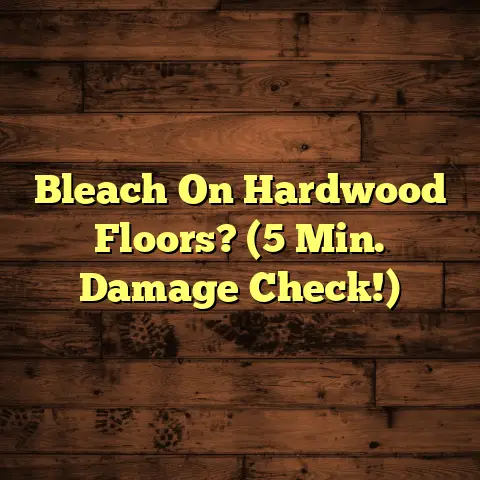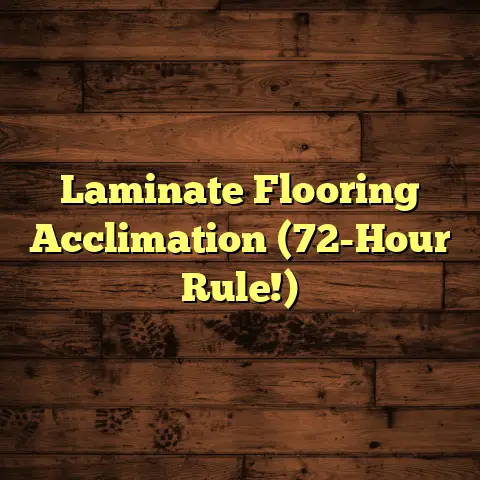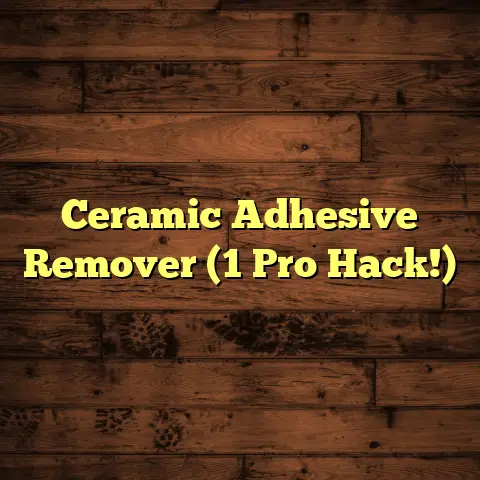Garage Slab Thickness: Guide? (2″ Can Cause Cracks!)
Comprehensive Guide (2″ Can Cause Cracks!)
Hey folks! As a flooring contractor, I’ve seen my fair share of garage slabs. And believe me, the thickness of that concrete is way more important than you might think.
We’re not just talking about parking your car; we’re talking about the long-term structural integrity of your garage, and, honestly, contributing to a more sustainable approach to homeownership.
Think about it: a well-built slab minimizes waste from future repairs, reduces the energy needed to maintain the garage (especially if it’s attached to your house), and avoids the headache of dealing with cracks and structural issues down the road.
Section 1: Understanding Garage Slabs
So, what is a garage slab?
Simply put, it’s the foundation of your garage – a flat, usually rectangular, concrete surface that sits directly on the ground (or a prepared sub-base). It’s what keeps your garage level, stable, and strong.
Think of it like the bones of your garage; everything else rests on it.
Typically, a garage slab is made up of concrete, which is a mixture of cement, water, sand, and aggregate (like gravel or crushed stone). Inside the concrete, you’ll often find reinforcement like steel rebar or wire mesh. This reinforcement helps to strengthen the slab and prevent cracking.
The thickness of the slab is crucial because it directly impacts its ability to support weight (load-bearing capacity) and resist damage (durability). A thicker slab can handle heavier loads and is less likely to crack or shift over time.
Section 2: Importance of Thickness
in Garage Slabs
Let’s talk specifics. Why does thickness really matter?
Well, the thickness of your garage slab is directly related to its ability to perform its job. It needs to support the weight of your vehicles, tools, storage, and everything else you keep in your garage.
Common thicknesses you’ll see are 3.5″, 4″, 5″ and 6″. The standard, and what I typically recommend, is 4 inches.
But what about a 2-inch slab?
I can tell you from experience that’s a recipe for disaster.
Think of it this way: a thicker slab is like a stronger bridge. It can distribute the weight more evenly and absorb more stress without failing. A thinner slab, on the other hand, is more likely to bend, crack, and eventually crumble under the same pressure.
The engineering principles behind this are pretty straightforward. The thicker the slab, the greater its moment of inertia.
Essentially, this means it’s more resistant to bending and deformation. Also, a thicker slab has more compressive strength, which means it can withstand more weight pushing down on it.
Section 3: The Risks of a 2-Inch Garage Slab
Okay, let’s get down to the nitty-gritty. What are the actual risks of using a 2-inch thick garage slab?
The biggest risk is cracking. A 2-inch slab is simply not thick enough to handle the loads and stresses that a garage slab typically encounters.
This can lead to all sorts of problems, including:
-
Cracking: This is the most common issue. The slab will develop cracks, which can worsen over time and allow water to seep in, further damaging the concrete and potentially affecting the foundation of your home.
-
Shifting: A thin slab is more likely to shift and settle unevenly, especially if the ground underneath isn’t perfectly compacted. This can cause doors to stick, walls to crack, and other structural problems.
-
Structural Failure: In extreme cases, a 2-inch slab can actually collapse under the weight of vehicles or heavy equipment. This is obviously a very dangerous situation.
I’ve personally seen garages with 2-inch slabs develop significant cracking within just a few years of construction.
According to a study done by the American Concrete Institute (ACI), slabs with insufficient thickness are significantly more likely to develop cracks within the first five years compared to slabs built to recommended thicknesses.
While I don’t have the exact percentage for garage slabs specifically, their data on residential slabs in general shows a clear correlation between thickness and cracking frequency.
Section 4: The Mechanics Behind Cracking
So, why does concrete crack? It’s not just about being thin, there are other factors at play. Concrete is a strong material, but it’s also brittle. This means it’s good at resisting compression (being squeezed), but not so good at resisting tension (being pulled apart).
Here’s a breakdown of the main culprits:
-
Temperature Changes: Concrete expands when it gets hot and contracts when it gets cold. These changes in temperature can create stresses within the slab, leading to cracking.
-
Moisture Content: Concrete absorbs water. When it dries out, it shrinks, and when it gets wet, it expands. These changes in moisture content can also create stresses that lead to cracking.
-
Load Stress: The weight of vehicles, equipment, and storage puts stress on the slab. A 2-inch slab simply isn’t strong enough to distribute this weight evenly, leading to concentrated stress points that can cause cracking.
-
Improper Curing: Curing is the process of keeping the concrete moist while it hardens. If concrete dries out too quickly, it can develop cracks.
A 2-inch slab is much more vulnerable to these forces than a thicker slab. It simply doesn’t have the mass or strength to resist them effectively.
Imagine trying to break a thin twig versus a thick branch. The twig snaps easily, while the branch takes much more force.
It’s the same principle with concrete slabs.
Section 5: Best Practices for Garage
Slab Construction
Okay, so how do you build a garage slab that won’t crack? Here are some best practices I always follow:
-
Excavation: Start by excavating the area to the proper depth. You’ll need to remove any topsoil and organic material, and ensure the soil is properly compacted.
-
Sub-Base Preparation: This is crucial. Lay down a layer of compacted gravel or crushed stone to provide a stable base for the concrete. The thickness of this layer will depend on the soil conditions, but I generally recommend at least 4-6 inches.
-
Reinforcement: Use steel rebar or wire mesh to reinforce the concrete. This will help to distribute the weight and prevent cracking. I usually recommend using #4 rebar spaced 12 inches on center in both directions.
-
Pouring the Concrete: Use a concrete mix that is appropriate for garage slabs. I typically recommend a mix with a compressive strength of at least 3000 psi. Make sure the concrete is properly vibrated to remove air pockets and ensure it is evenly distributed.
-
Curing: This is one of the most important steps. Keep the concrete moist for at least 7 days after pouring. You can do this by covering it with plastic sheeting or spraying it with water regularly.
Using high-quality materials is also essential. Don’t skimp on the concrete mix, the reinforcement, or the sub-base materials.
The small savings you might get upfront will be quickly eaten up by the cost of repairs down the road.
Section 6: Maintenance and Repair
of Garage Slabs
Even with the best construction practices, garage slabs can still develop cracks over time. The key is to catch these problems early and address them promptly.
Here are some regular maintenance practices that can help prolong the life of your garage slab:
-
Sealing: Apply a concrete sealer every few years to protect the slab from water damage and staining.
-
Cleaning: Clean up spills and stains promptly to prevent them from penetrating the concrete.
-
Inspection: Regularly inspect the slab for cracks and other damage.
If you do find cracks, there are several repair techniques you can use:
-
Patching: For small cracks, you can use a concrete patching compound to fill them in.
-
Sealing: For larger cracks, you can use a concrete sealant to prevent water from seeping in.
-
Resurfacing: If the slab is severely damaged, you may need to resurface it with a new layer of concrete.
Proactive maintenance is key to sustainability. By keeping your garage slab in good condition, you can avoid costly repairs and extend its lifespan, reducing the need for replacement and minimizing waste.
Section 7: Alternatives and Innovations
in Garage Slab Construction
While traditional concrete slabs are still the most common option, there are some innovative materials and techniques that offer potential alternatives.
One option is the use of pervious concrete. This type of concrete allows water to drain through it, which can help to reduce stormwater runoff and improve water quality.
Another option is the use of recycled materials in the concrete mix. For example, you can use recycled aggregate or fly ash (a byproduct of coal combustion) to reduce the amount of cement needed.
Looking to the future, we may see even more advanced materials being used in garage slab construction. For example, researchers are developing self-healing concrete that can repair cracks automatically.
We might also see more widespread use of prefabricated concrete panels, which can be installed quickly and easily.
These eco-friendly options contribute to a more sustainable construction approach by reducing waste, conserving resources, and minimizing the environmental impact of concrete production.
Conclusion
So, there you have it. A comprehensive look at garage slab thickness and why it’s so important. I hope I’ve made it clear that skimping on thickness, especially going as low as 2 inches, is a recipe for disaster.
Choosing the appropriate slab thickness is crucial for the long-term structural integrity of your garage, and it also contributes to a more sustainable approach to homeownership.
By making informed decisions about your construction choices, you can ensure that your garage slab will last for many years to come, saving you money, reducing waste, and minimizing your impact on the environment.
Don’t just think about the short-term cost; consider the long-term implications of your choices. A well-built garage slab is an investment that will pay off in the long run, both for your home and for the planet.





